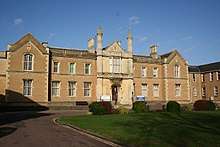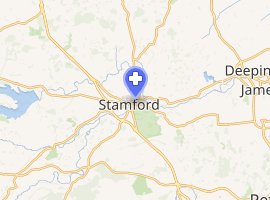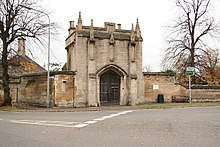Stamford and Rutland Hospital
Stamford and Rutland Hospital is an elective care hospital in Stamford, Lincolnshire administered by North West Anglia NHS Foundation Trust.
| Stamford and Rutland Hospital | |
|---|---|
| North West Anglia NHS Foundation Trust | |
 Stamford and Rutland Hospital | |

| |
 Shown in Lincolnshire | |
| Geography | |
| Location | Stamford, Lincolnshire, England, United Kingdom |
| Coordinates | 52.655159°N 0.4718503°W |
| Organisation | |
| Care system | Public NHS |
| Type | Community |
| Services | |
| Emergency department | No Accident & Emergency |
| Beds | 22 |
| Links | |
| Website | www |
| Lists | Hospitals in England |
History

The hospital was built on a site previously occupied by Greyfriars, Stamford and donated by the Marquess of Exeter. It was funded by a bequest from the will of surgeon Henry Fryer, designed by John Peter Gandy and opened in 1828.[1]
Between 1876 and 1879 the hospital was expanded with the addition of three fever ward blocks, under architect Edward Browning with input from surgeon Dr William Newman. The wards incorporated a number of features such as centralised ward interiors and glazed internal walling, and were cited as an exemplar of single-block planning for small hospitals, particular by Henry Burdett. The fever wards are Grade II listed and are a testament to how voluntary hospitals dealt with nineteenth century epidemics of contagious disease.[2]
A substantial redevelopment of the hospital was completed in July 2017, which included new imaging facilities, including a permanent MRI scanning suite, and cancer treatment facilities.[3]
Services
The hospital provides a minor injuries unit, large scale outpatient services and day-case surgery, with the largest pain management centre in the region.[4] It also has a medicine for the elderly ward with 22 intermediate care beds.[3] The trust's largest hospital, Peterborough City Hospital, provides the majority of emergency and inpatient services in the area; the two together thus provide a comprehensive suite of services in a predominantly "hot" and "cold" split.[5] It was rated "good" by the Care Quality Commission in May 2014.[6]
References
- "Stamford and Rutland General Infirmary, Deeping Road, Stamford, Lincolnshire". Historic England. Retrieved 13 October 2017.
- Kathryn A Morrison (2015). "The Fever Wards, Stanford Hospital, Lincolnshire" (PDF). Historic England. ISSN 2059-4453.
- "Stamford and Rutland Hospital". North West Anglia NHS Foundation Trust. Retrieved 14 October 2017.
- "Stamford and Rutland Hospital – Departments and services". NHS Choices. Department of Health. Retrieved 6 October 2017.
- Imison, Candace; Sonola, Lara; Honeyman, Matthew; Ross, Shilpa (25 November 2014). The reconfiguration of clinical services: What is the evidence?. The King's Fund. ISBN 9781909029439.
- "Stamford and Rutland Hospital". Care Quality Commission. Retrieved 14 October 2017.